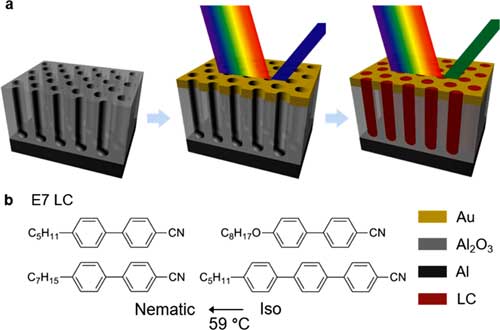| Posted: Jul 16, 2017 | |
Using nanoconfined liquid crystals to make a switchable plasmonic film(Nanowerk News) Researchers from Korea Advanced Institute of Science and Technology (KAIST) have successfully fabricated a switchable plasmonic film using liquid crystal (LC) material infiltrated into a gold-coated porous anodic aluminum oxide (AAO) film. |
|
| They have reported their findings in ACS Applied Materials & Interfaces ("Switchable Plasmonic Film Using Nanoconfined Liquid Crystals") | |
 |
|
| Plasmonic reflection. (a) Schematic illustration of fabrication of switchable plasmonic structure. (b) Chemical structure of the LC. (© American Chemical Society) | |
| LC materials are generally stable under ambient conditions and are optically anisotropic, and thus LC materials have been widely used in display applications. Porous AAO films are good candidates for plasmonic structures because they spontaneously form uniform cylindrical pores and channels with millimeter-scale dimensions. | |
| The molecular orientation of LC materials in pores can be controlled to show one principal LC refractive index in the nematic phase, which can be varied by thermal phase transition, revealing a wavelength shift in plasmonic reflection. | |
| The reflected colors varied by varying the geometrical parameters and the phase transition of the LC material from the isotropic to the nematic phase, which changed the effective refractive index, giving rise to the red shift of the plasmonic reflection. | |
| "The nonvolatile characteristics of the LC material preserved the color change, enabling us to write letters on our plasmonic canvas, which is reusable without damage," the authors write. | |
| "Beyond sensing applications, our platform, based on a collaboration between LC material and plasmonic nanostructures, has potential for use in many applications, including color painting and display," they conclude. "Most of all, our approach is simple, inexpensive, and robust, which is essential for practical uses." |
 By
Michael
Berger
– Michael is author of three books by the Royal Society of Chemistry:
Nano-Society: Pushing the Boundaries of Technology,
Nanotechnology: The Future is Tiny, and
Nanoengineering: The Skills and Tools Making Technology Invisible
Copyright ©
Nanowerk LLC
By
Michael
Berger
– Michael is author of three books by the Royal Society of Chemistry:
Nano-Society: Pushing the Boundaries of Technology,
Nanotechnology: The Future is Tiny, and
Nanoengineering: The Skills and Tools Making Technology Invisible
Copyright ©
Nanowerk LLC
|
|
|
Subscribe to a free copy of one of our daily Nanowerk Newsletter Email Digests with a compilation of all of the day's news. |
